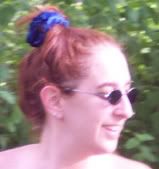The Disney Police
If the Waldorf people hadn’t gotten to us first, we’d never have figured it out, but Caytlynn started preschool in an atmosphere devoid of those influences. You know—influences that have kids clamoring for a T-shirt, or cereal box, or cheap plastic toy because some corporate entity spent millions ensuring that your child recognizes, adores, and identifies with their licensed character.
Caytlynn didn’t know anyone with a TV, couldn’t name the popular branded figures, and never begged for colorful garbage. At six, she was into insects, and asked for magnifying glasses, butterfly nets, and bug books. We were the family with the home haircuts, dressed in natural fibers, picnicking in the park while our child observed ants.
Judy, the widow next door, wore polyester pantsuits and reading glasses on a beaded chain. She offered unsolicited advice regarding ladylike behavior along with small presents—Spongebob taffies and Barbie flip-flops.
“Aren’t you a little angel?” Judy asked.
Caytlynn puffed out her chest. “I’m an entomologist.”
In a pinch, we left Caytlynn in Judy’s care for fifteen minutes here, an hour there. “What did you do?” we’d ask later.
“Watch TV.” Caytlynn would shrug and go back to her mealworms and beetles. “Can you cut an apple, Dad? They’re hungry.” Later, she added, “I think she’s lonely.”
“The mealworm?”
“Judy. Maybe I should go there. I mean, not just when you can’t find a babysitter.”
Jennie smiled, pleased to have raised such a compassionate child, and arranged for her to visit on Wednesdays and Saturdays.
Caytlynn watched TV to be polite and thanked Judy for increasingly elaborate presents: Mickey Mouse ears, Hannah Montana CDs, princess costumes. Then she came home, asked Jennie to give the silly things to Goodwill, and informed her that we must plant milkweed to attract monarch butterflies.
The only weird thing about Judy was the night Jennie reminded me, at one a.m., to take the trash out, and I clearly heard a man’s voice, stern and low, from Judy’s kitchen. “If you can’t seal the deal, we’ll send someone who can.”
“They’re tough,” Judy said, her voice strained. “Intellectual.”
“Take this,” the man said, and handed her a wrapped package. Rectangular. About the size of two DVD boxes. “And finish it, or you’re through.”
That Wednesday, Caytlynn came home from Judy’s with two DVDs: A Bug’s Life and Antz.
On Sunday, Judy accosted me over the forsythia hedge. “I’m worried about your daughter's imagination.”
“Because she thought Antz was unrealistic?”
Judy shook her head and toddled up her driveway.
Two weeks later, a moving van pulled up to the house. “Moving in with my daughter,” she said.
“She never said she had a daughter,” Caytlynn observed. “I hope the new people have kids. Or a spitting cockroach.”
But the middle-aged woman in the polyester pants suit who waved over the forsythia hedge a few weeks later brought neither children nor Blattaria, only an open invitation to sample her gluten-free, vegan macaroons. Mary’s association with Caytlynn seemed natural, for she was unafraid to help our daughter collect cicada carapaces and arrange them according to size. Now and again she presented Caytlynn with a realistic plastic toy insect.
“The tops are all right,” Caytlynn said, “but the bottoms are wrong.” Still, she lined them up on the windowsill, cautioning visitors not to examine the anatomically incorrect undersides.
Still, we wouldn’t have caught on, until the day Caytlynn called out to me from Mary’s bedroom window, “Dad! Dad! Mary fell down! And she’s talking funny! I called 911.”
“She’s burning up,” I said when I got over there, so I opened her hall closet, looking for a washcloth to cool her fevered brow, but found no linen.
Her closet contained row upon row of plastic toys. One shelf held dozens of the semi-accurate insects, along with the characters from A Bug’s Life, but there were lines of Tinkerbells, scores of princesses, stacks of plush cartoons characters.
On the bottom shelf, my daughter’s name jumped out from a green file folder. My heart stopped.
The file contained pictures of my daughter running through meadows with butterfly nets, squinting through her microscope, climbing trees; charts of her likes and dislikes; her schedule, my schedule, and Jennie’s schedule; what we ate for dinner, movies we’d attended, our browser history, and on and on. Records going back years, from Caytlynn’s first day at Waldorf.
Beneath that, a dog-eared handbook—Creating Collectors: Enforcing Commercialization. It began, “Enforced commercialization builds a sturdy economy through strong habits of consumerism fostered prior to the age of 8. The Corporation’s efforts toward conspicuous consumption encourage the consumer to create interest channels based on collectability.”
And bookmarked and underlined, page 144: “In cases where the subject’s parents have successfully resisted commercialism (c.f. “intellectuals”) operatives may befriend subjects via academic interests to establish trust before embarking on standard enforcement techniques. See appendix of educational toys.
In the madness that ensued with the arrival of paramedics, those incriminating publications disappeared. Mary disappeared, too, once the ambulance doors closed. A month later, a kindly, middle-aged woman in a polyester pants suit moved next door, but Caytlynn was forbidden to talk to her.
Saturday, April 10, 2010
The Disney Police
Subscribe to:
Comments (Atom)


